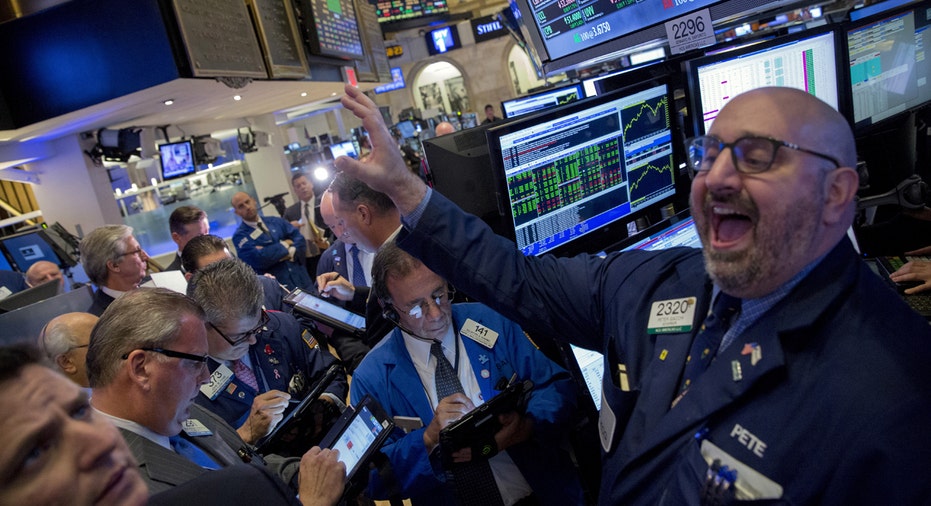Lion's Roar: Stocks March Higher to Kickstart New Month

U.S. equity markets roared higher on Tuesday as traders digested better-than-expected factory data, and cheered comments from a key Federal Reserve official.
The Dow Jones Industrial Average was up 346 points, or 2.10% to 16863. The S&P 500 added 45 points, or 2.37% to 1978, while the Nasdaq Composite rose 131 points, or 2.89% to 4689.
The financials, technology, and consumer discretionary sectors were the best performers, rising more than 2% each, as utilities declined.
Today’s Markets
After a mostly flat end to February on the broader averages, and a 1% drop on the Nasdaq, Wall Street did an about face on Tuesday as it turned the calendar’s page to March. The broader averages notched their highest percentage gains since January, while the Nasdaq rallied the most since August.
Adding to improving sentiment were comments from New York Federal Reserve President William Dudley. In remarks at a conference in China sponsored by both the nation’s central bank and the New York Fed, Dudley said risks to the U.S. economy could push the Fed to wait longer before moving forward with another rate hike.
“At this moment, I judge that the balance of risks to my growth and inflation outlooks may be starting to tilt slightly to the downside,” he said.
He later added that “on balance, I am somewhat less confident than I was before.”
Still, Dudley said he sees 2016 U.S. growth at about 2%, which, in his view, would help push further improvement in the labor market and move inflation ever closer to the central bank’s 2% target.
The Fed’s policy-setting Federal Open Market Committee will meet later this month on March 15 and 16 and provide an update on its economic outlook in a statement and press conference following the two-day meeting. The FOMC is not expected to raise rates at that meeting.
Larry Shover, chief investment strategist at Solutions Funds Group, said although other global central banks including the Bank of Japan and the European Central Bank have dipped rates into negative territory, there’s little risk of the Fed following suit.
“Inflation data in particular has been surprisingly strong of late, including the PCE out Friday. But also the CPI and wage numbers, too. And this is occurring with a headwind still coming from oil – if crude can continue stabilizing, that would place further upside pressure to inflation readings,” he explained.
Shover continued by saying while the Fed is unlikely to move in March, it’s not unreasonable to assume at least one more rate hike by the end of the year.
The U.S. central bank will continue to keep a close eye on key economic data ahead of its next meeting. Figures on the health of the economy in January were mixed. Wall Street will be looking for any improvements made in February.
Traders digested better-than-expected manufacturing figures from the Institute for Supply Management on Tuesday. The closely-watched gauge rose to 49.5 last month from 48.2 in January. Expectations were for a shallower rise to 48.5. The reading was still below the 50 line that separates expansion from contraction, but advanced to the highest level since September. The new orders index in February remained steady at 51.5, while the employment index unexpectedly rose to 48.5 from 46.4. Forecasts were for a decline to 45.9.
The data follow global PMI data out on Tuesday. European figures were a bit better than expected. Overall eurozone manufacturing improved slightly from January as its gauge rose to 51.2 from 51. Meanwhile, France and Germany were in line with expectations, while the U.K. dipped to the lowest level of expansion since 2013.
In Asia, China’s Caixin manufacturing gauge slid to 48 from 48.4, while Japan remained mostly in line with January figures.
IG market analyst Joshua Mahony said in a note that as the China economy continues to move toward domestic consumption, data highlight that the path to sustainable growth is still far off.
“The deterioration in Chinese manufacturing is becoming more pronounced by each month that passes, with a seven-year low in the headline reading trumped by the twelfth-consecutive contractionary reading in the privately compiled Caixin measure,” he explained.
Elsewhere in the market, global oil prices gained again as investors continued to hope some of the biggest producers will agree to cap production and help alleviate downward pressure caused by a growing supply glut.
In recent action, West Texas Intermediate crude added 1.93% to settle at $34.40 a barrel, the highest level since January 28. Brent, the international benchmark gained 0.66% to $36.81 a barrel.
Metals were lower as gold declined 0.29% to $1,230 a troy ounce and silver slid 1.09% to $14.73 an ounce. Copper gained 0.61%at $2.14 a pound.
Meanwhile, the yield on the benchmark 10-year U.S. Treasury bond rose 0.090 percentage point to 1.830%. Yields move inversely to prices. The U.S. dollar gained 0.15% against a basket of global currencies.



















